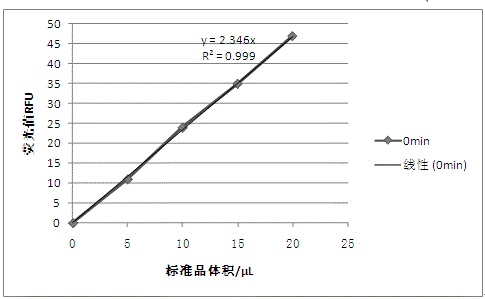Reagent for detecting lipase and method for rapidly detecting lipase
A technology for detecting reagents and lipase, which is applied in the direction of material excitation analysis, fluorescence/phosphorescence, etc., can solve the problems of unsuitable food detection, poisonous nitrophenol, low stability, etc., to save detection time, accurately and quickly detect, detect fast effect
- Summary
- Abstract
- Description
- Claims
- Application Information
AI Technical Summary
Problems solved by technology
Method used
Image
Examples
Embodiment 1
[0047] Embodiment 1: the preparation of working solution C
[0048] 1) Weigh 8g of NaCl, 0.2g of KCl, NaCl 2 HPO 4 1.42g and KH 2 PO 4 0.27g, add 800ml of ultrapure water to dissolve, dilute to 1L with ultrapure water, prepare as liquid A after high-temperature sterilization, and store at 4°C;
[0049] 2) Take 2.5ml of 1.5mM 1,2-oxo-dilauryl-(±)glycerol-glutaric acid-6'-methyl-resorufin ester, 150μl of 0.5M sodium acetate pH 4.0 buffer Solution, 25μl Tween 20 and 10μl Proclin 300, add water to make up to 50ml, that is, prepare as B solution, store at 4°C in the dark;
[0050] 3) Mix liquid A and liquid B at a volume ratio of 2:1 to prepare working liquid C.
[0051]
Embodiment 2
[0052] Embodiment 2: standard curve drawing
[0053] 1) Add 5, 10, 15, and 20 μL of standard products with a concentration of 100 μM to the 96-well ELISA plate, and then add 200 μL of the working solution C prepared according to Example 1 to each well, mix well, and the blank control is the corresponding volume working solution C;
[0054] 2) Put the microplate plate into a preheated fluorescent microplate reader at 37°C, excite with an excitation wavelength of 520nm, detect at an emission wavelength of 610nm, and read the fluorescence value as A 标 , the blank control is A 空 , with the fluorescence value of the standard (A 标 -A 空 ) is the ordinate (unit is RFU), and the volume of the standard product is the abscissa (unit is μL), draw the standard curve.
[0055] The obtained standard curve is as figure 1 As shown, the standard curve is very linear, the linear equation is y=2.58x, and the correlation coefficient R2 is 0.998.
[0056]
Embodiment 3
[0057] Embodiment 3: Determination of raw material milk and pasteurized milk lipase enzyme activity
[0058] 1) Take 2 raw milk samples, named 1# and 2#, and take a pasteurized milk sample, named 3#;
[0059] 2) Add 10 μL of samples to the 96-well ELISA plate, add 200 μL of working solution C to each well, mix well, and use the corresponding volume of working solution C as the blank control;
[0060] 3) Put the microplate plate into a fluorescent microplate reader preheated at 37°C, excite with an excitation wavelength of 520nm, detect at an emission wavelength of 610nm, read the fluorescence value, and record it as A1 样 , the blank control is recorded as A1 空 ; After incubation for 40min, read the fluorescence value again and record it as A2 样 , the blank control is recorded as A2 空 ;
[0061] 4) The fluorescence value of the sample [A 样 =(A2 样 -A2 空 )-(A1 样 -A1 空 )] into the standard curve, read the corresponding standard volume (B) of the sample from the standard c...
PUM
 Login to View More
Login to View More Abstract
Description
Claims
Application Information
 Login to View More
Login to View More - R&D
- Intellectual Property
- Life Sciences
- Materials
- Tech Scout
- Unparalleled Data Quality
- Higher Quality Content
- 60% Fewer Hallucinations
Browse by: Latest US Patents, China's latest patents, Technical Efficacy Thesaurus, Application Domain, Technology Topic, Popular Technical Reports.
© 2025 PatSnap. All rights reserved.Legal|Privacy policy|Modern Slavery Act Transparency Statement|Sitemap|About US| Contact US: help@patsnap.com



